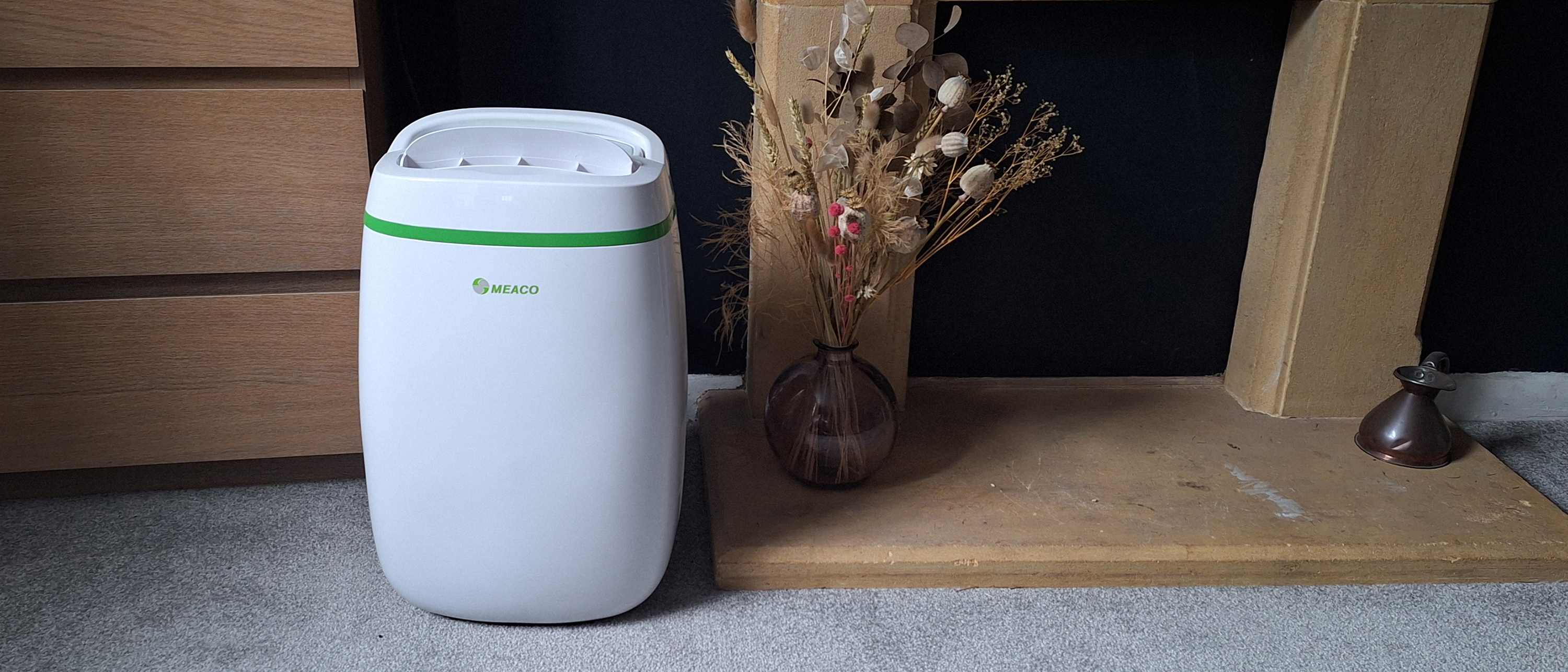TechRadar Verdict
The Meaco 12L Low Energy Dehumidifier (also available in a 20L version) is an efficient and effective dehumidifier that can double up as a basic air purifier, or operate as each individually. The design is functional if not especially stylish, and you have the option to set it to a timer and adjust target humidity settings – provided you can get to grips with the old-school button and display operation. There are more advanced, hi-tech options on the market; but if you just want something functional and cheap to run, this Meaco model will do the trick.
Pros
- +
Optimised for low energy use
- +
Timer option
- +
Great for drying clothes
- +
Functional design
- +
Can also purify your air
Cons
- -
Not the most stylish-looking
- -
Confusing, fiddly controls
- -
Stronger options in Meaco range
- -
No quieter "night" mode
Why you can trust TechRadar
Meaco Low Energy Dehumidifier: two-minute review
The Meaco 12L Low Energy Dehumidifier – also known as the Meaco 12LE – is a dehumidifier with a sideline in air purification. The 12L model I tested for this review is designed for smaller homes, but it's also available in a 20L version for larger spaces.
The styling is functional, and it does pretty much everything you'd want a dehumidifier to do. You can adjust target humidity levels between 30% and 80%, or set it to run for a certain number of hours. I found it was a game-changer for drying laundry in my basement flat, collecting an impressive/concerning volume of water and considerably speeding up the drying process. The adjustable vents mean you can direct the airflow at your washing, too.
Rather than being the main focus, the air purification is a handy by-product of dehumidification. Air is flowing through the machine already, so pop in the supplied HEPA filter and – hey, presto! – an air purifier. However, don't expect the data and intelligent purification you'll find with today's best air purifiers.
There is a setting that enables you to use it just as an air purifier – and, likewise, you can remove the filter and use it just as a dehumidifier. That actually may be a good idea in some cases, since the filter makes the dehumidifying less efficient. I like that the Meaco 12LE can be adjusted for seasonal use – I need a dehumidifier in the winter months, while in the summer an air purifier would be ideal to cope with allergies; this can be both, without taking up unnecessary space in my flat.
The USP here is that the Meaco Low Energy Dehumidifier is, well, low energy, meaning it should be cheap to run. The quoted running costs of 4p per hour (or 5p for the 20L version) are certainly among the lowest I've found, although comparing between manufacturers can be tricky.
On test, I had no issues with the performance – everything worked as advertised, and the design functions well. Having grown used to user-friendly companion apps, I found the old-school controls here fiddly and confusing to start. Everything is set using buttons, and you're relying on indicator lights and a basic, two-digit display to provide all the information you need. This is one situation in which you'll definitely need to read the user manual.
My main complaint is that, quite simply, Meaco makes another product that is all-round better and costs the same. The Meaco Arete Two does everything the Low Energy version does but more efficiently (so with lower running costs), and with added functions including optional app control to sweeten the deal further. The 12LE is decent value for its upper mid-range price tag, but it's worth shopping around in the Meaco range before buying.
That's the short version; read on for my full Meaco Low Energy Dehumidifier review.
Meaco Low Energy Dehumidifier review: price & availability
- List price: £198.95 for 12L, £289.99 for 20L
- Available: UK
At list price, the 12L version of this dehumidifier costs just under £200, putting it at the top end of TechRadar's mid-range price bracket for dehumidifiers. The 20L version sits in the premium bracket, which is what I'd expect for a large-capacity model. At full price you're getting decent value for money here, but at time of writing, the 12LE and 20LE were discounted on the Meaco website to £149 / £204 respectively, making them even better value.
When choosing a dehumidifier, it's also worth factoring in ongoing running costs. Both LE models are designed to be cheap to run (4p or 5p per hour), which will save you money in the longer term.
However, there are models that offer added functionality for a similar price. Of these, Meaco's own Arete Two does everything the 12LE does and more, is cheaper to run, and has basically the same list price.
You can purchase these models direct from Meaco, as well as via a selection of third-party retailers such as Amazon, John Lewis and Currys. The Black Friday sales tend to be an especially good time to shop for appliance deals (although this might be more of a time-sensitive buy, so rest assured that discounts can be found year-round).
- Value for money score: 3.5 out of 5
Meaco Low Energy Dehumidifier specs
| Header Cell - Column 0 | 12L Low Energy Dehumidifier (tested) | 20L Low Energy Dehumidifier |
|---|---|---|
Size (D x W x H): | 24.8 x 32.5 x 48.5cm | 29 x 38.5 x 59.5cm |
Weight: | 10kg | 13.6kg |
Airflow: | 100m³/h | 160m³/h |
Filter type: | HEPA | HEPA |
Noise level: | 41dB | 46dB |
Power consumption: | 157W | 219W |
Full tank auto cut-off: | Yes | Yes |
Timer: | Yes | Yes |
Cost to run (based on 24.50p/kWh): | 4p per hour | 5p per hour |
Cable length: | 2m | 2m |
Tank size: | 2.5L | 6L |
Meaco Low Energy Dehumidifier review: design
- Available in 12L (tested) and 20L versions, for different-sized spaces
- Combination dehumidifier and air purifier with HEPA filter
- Controlled via fiddly panel on top
The Meaco Low Energy Dehumidifier is primarily a dehumidifier, but comes with a HEPA filter that you can add to turn it into an air purifier. It's available in two size options; the 12L version I tested is designed for smaller homes of up to three bedrooms, while the 20L version is recommended for larger homes with up to five bedrooms. Design-wise, both models are similar; but the 20L version has slightly different specs and a couple of bonus functions compared to the 12L.
At the top of the machine you'll find the control panel, air outlet with vents that can be manually opened and closed, plus a sturdy plastic handle for moving the dehumidifier around your home. The vents are designed so you can direct the airflow – for example, towards your drying laundry.
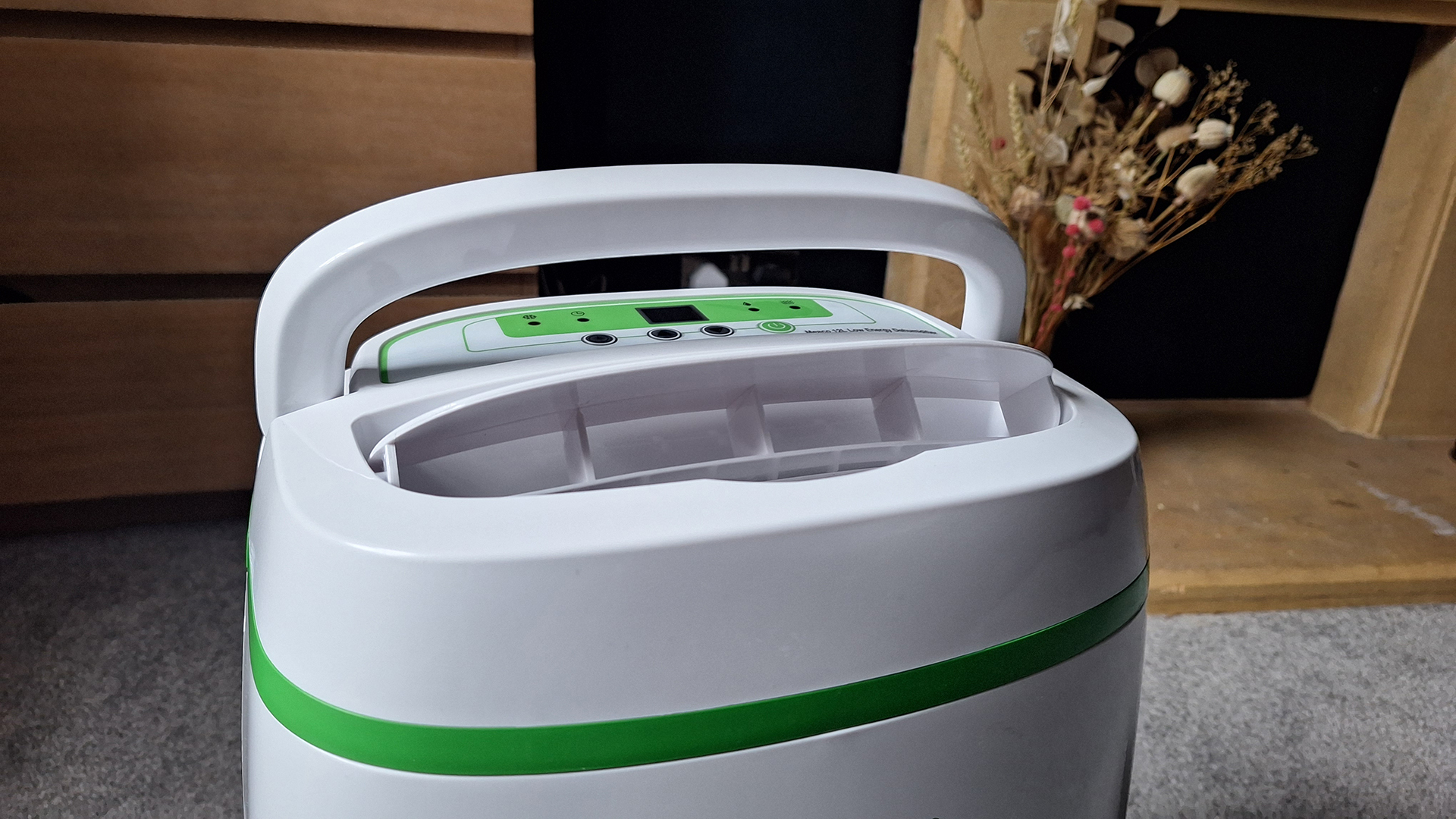
The water tank is located on the back of the 12L machine, and the front of the 20L version. This can be pulled in and out. It contains a float that means it will automatically cut off when it's full, and it has a lid to help prevent spillages – this is useful because getting it in and out is a little fiddly (that has been true of all dehumidifiers I've tried).
It's possible to empty the tank without taking off the lid, via a hole in the corner; but it's also removable, to enable you to clean the inside of the tank as needed. There's an outlet, too, if you want to add a water pipe (not provided) for continuous drainage. I did not test this out.

Above the water tank is the air inlet grille, behind which you can slot in your filter if you want the machine to perform as an air purifier. I was a little surprised to learn in the instruction manual that adding the filter will make the dehumidification less efficient – on the 12L version, adding a filter results in 11% less dehumidification and 7% more energy use; on the 20L version, it's 9% less dehumidification and 5% more energy.
The larger 20L version also features a cable tidy, so you can wrap the 2m power cord out of the way. There's no space for this on the 12L version I tested.
In terms of looks, the Meaco unit isn't the most stylish I've tested. The white plastic build with green detailing is perfectly functional, and I'd be happy to have it sit in my utility room (if I had one, that is); but perhaps it isn't for permanent display in my living room.
Controls
On the top side of the appliance you'll find the control panel. On the 12L version, this compromises an on/off button, up and down arrow buttons, and a timer button. There's also a basic digital display, and four indicator lights. The 20L version features all of the above, plus a couple more buttons to operate additional modes.
The arrows are used to set the relative humidity level, between 30% and 80% in increments of 5, shown on the digital display. In the instruction manual, Meaco recommends a good humidity level for a home is 50% or 55%. The dehumidifier will automatically go to sleep when the target humidity level is reached. After 30 minutes, it will wake up and begin the dehumidification process again.
When cycling through humidity levels, you'll also see a couple of different mode options:
- CO mode: for continuous dehumidifier, stopping only when tank is full
- AP mode: air purification only, no dehumidification
If you want the dehumidifier to run for a set number of hours and then stop, you use the timer button. You can set between one and 24 hours, in one-hour increments.
When the water tank becomes full, the machine will bleep multiple times, the indicator light beneath a wave icon will illuminate, and operation will pause. Once the tank has been emptied and correctly replaced, the dehumidifier will resume operation as per its previous settings.
If the indicator light below the snowflake icon comes on, it means the automatic defrosting system has kicked in. This is to ensure the machine continues to run efficiently even in low temperatures, although it isn't recommended you use it in temperatures below 5ºC.
If you opt for the 20L version, there's also a fan speed button (swap between low and high), and a louvre swing button (for an oscillating airflow from the vents). You can also child-lock the dehumidifier by pressing the up and down arrows for three seconds – strangely, this isn't an option on the 12LE.
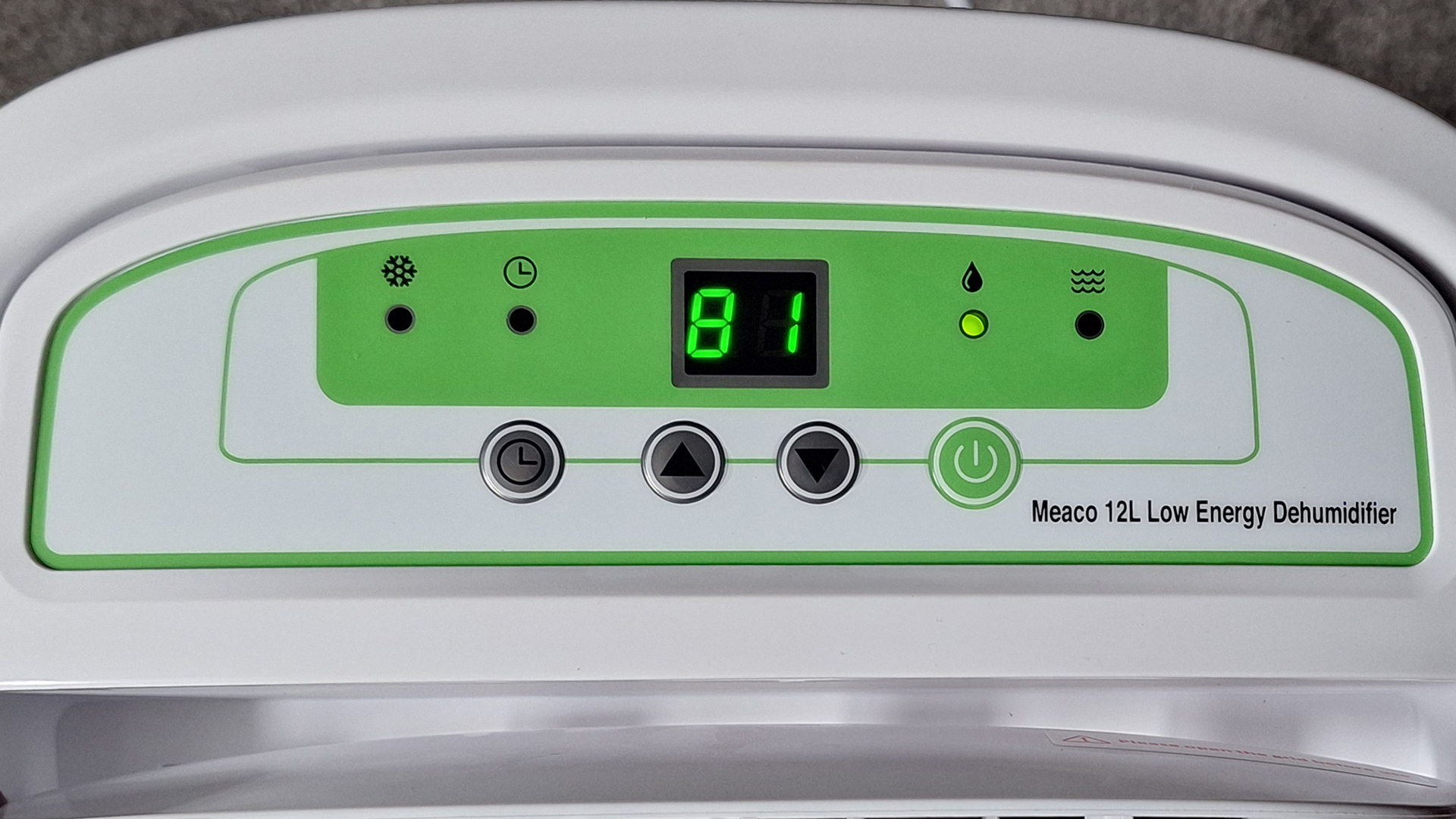
When the dehumidifier is on, the digital display will show the current relative humidity level. Pressing the down arrow will show either the target humidity level, AP or CO.
Overall, the controls reminded me a little of trying to set a VCR timer record, or change my car clock – a little too fiddly in this day and age. There's no button to press to confirm your selection, and because the display is limited to showing just two letters/numbers at a time, I was never quite sure what the machine was doing, and if I'd set it up correctly. At least if you switch the machine on and off using the button on top, it will remember your last-used settings.
While I don't love to have to download an app with every appliance I test, I wonder if one might have been helpful here. Meaco does have an app – its Arete Two dehumidifier comes with app control.
- Design score: 3.5 out of 5
Meaco Low Energy Dehumidifier review: performance
- Settings all work as promised
- Collected an impressive / worrying amount of water
- For air purification, not as advanced as a dedicated machine
The beauty of a two-in-one machine such as this is that you can use it for dehumidification in the winter, when the weather is wet and cold, and you don't want to have all the windows open, and then it can become an air purifier in the summer, when ventilation is easier but allergens are everywhere. I appreciate the fact that it can operate with each function individually – by removing the HEPA filter when you want just dehumidification, or putting it in AP mode for just purification.
Of course, it can do both things all year round if you'd rather, but do bear in mind the dehumidification is less efficient with the HEPA filter installed. I suspect most people won't realise this, unless they read the handbook thoroughly.
This model comes with a Quiet Mark award, and Meaco says the 12L unit operates at 41dB (from 1m away) while the 20L version is marginally louder at 46dB. On test, it was loud enough that I couldn't have it on in a room where I was watching TV or sleeping, or example, but it wasn't an unpleasant noise, and with the door closed and it running in the next room, it became a very acceptable background hum. Some dehumidifiers come with a quieter "night mode", but that isn't an option here.
The design is functional, if not especially beautiful. The range of modes and options offer plenty of control over how it's used, although in reality, given the fiddly nature of the control panel, I'd probably have preferred something like a single-press "laundry" mode where the machine just runs for four hours at a target humidity of 50%.
Dehumidification
My flat is basement level at the front and ground level at the back, and I do sometimes struggle with damp and condensation inside. I also have the issue of ventilation – it isn't a massive area, and I need to be able to cook, shower and occasionally dry clothes indoors at a time of year when it's not always practical to have the windows open.
For that reason, the Meaco dehumidifier has been a bit of a game-changer, in particular for drying clothes. During the winter, clothes take forever to dry, and I'm always concerned about damp getting into the walls. Adding a Meaco dehumidifier made a big difference here – I have been a little shocked by how much water collects, and how quickly, when it's been left on for this purpose. Plus, if it's been left running during the day, I haven't been greeted by a musty smell in my home, even if the windows have been closed.
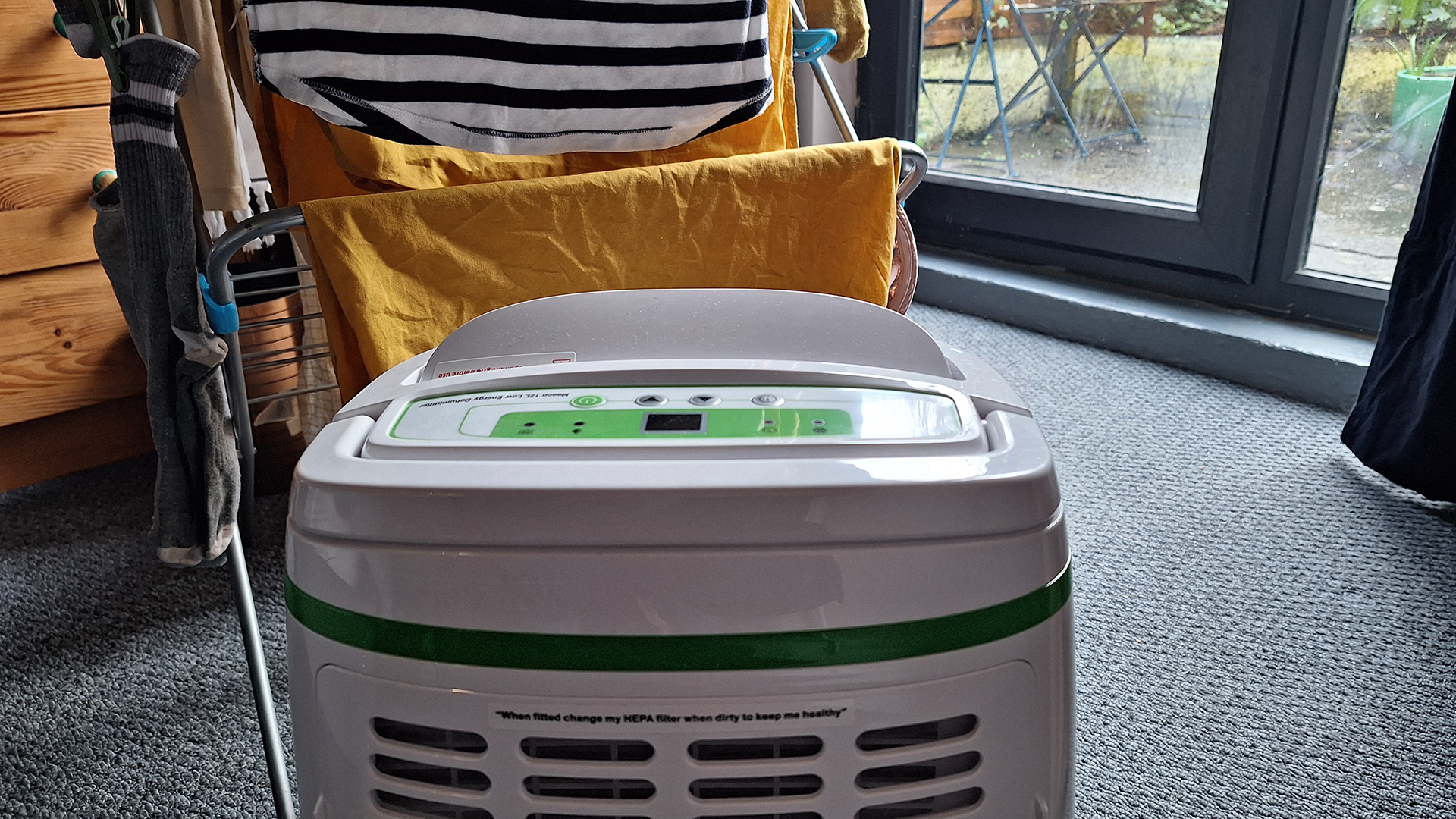
That's probably true of most dehumidifiers, but I appreciate in particular the fact that the vents on the Meaco can be angled to direct a breeze towards my clothes horse. The timer function is also useful for this – for example, if I'm going out for the day and just want it to be on for four or five hours.
The USP here is that the Meaco 12LE is designed to operate efficiently in terms of cost. Using a dehumidifier can help lower your heating bills in general, because dry air is easier to heat than damp air, so adding a dehumidifier theoretically means your heating system doesn't have to work as hard. But it's no good if you offset those heating savings with higher electricity costs from a machine that uses a ton of power. The 12L model here is meant to cost around 4p per hour to run, while the larger model is around 5p.
Air purification
I also tested this model out as an air purifier on its own, by putting it in AP mode and adding the True HEPA filter. That's the highest-quality filter used in consumer appliances, and will help remove particles and certain allergens – including mould spores, pollen, dust and pet dander – from the air. (Here's more on what air purifiers can and can't help with.)
This machine is primarily a dehumidifier – the air purification here is incidental; there's air flowing through the machine already, so by adding a filter, you can purify it at the same time as removing the water. So while there are lots of dehumidification settings, the air purifying is either happening or it isn't.
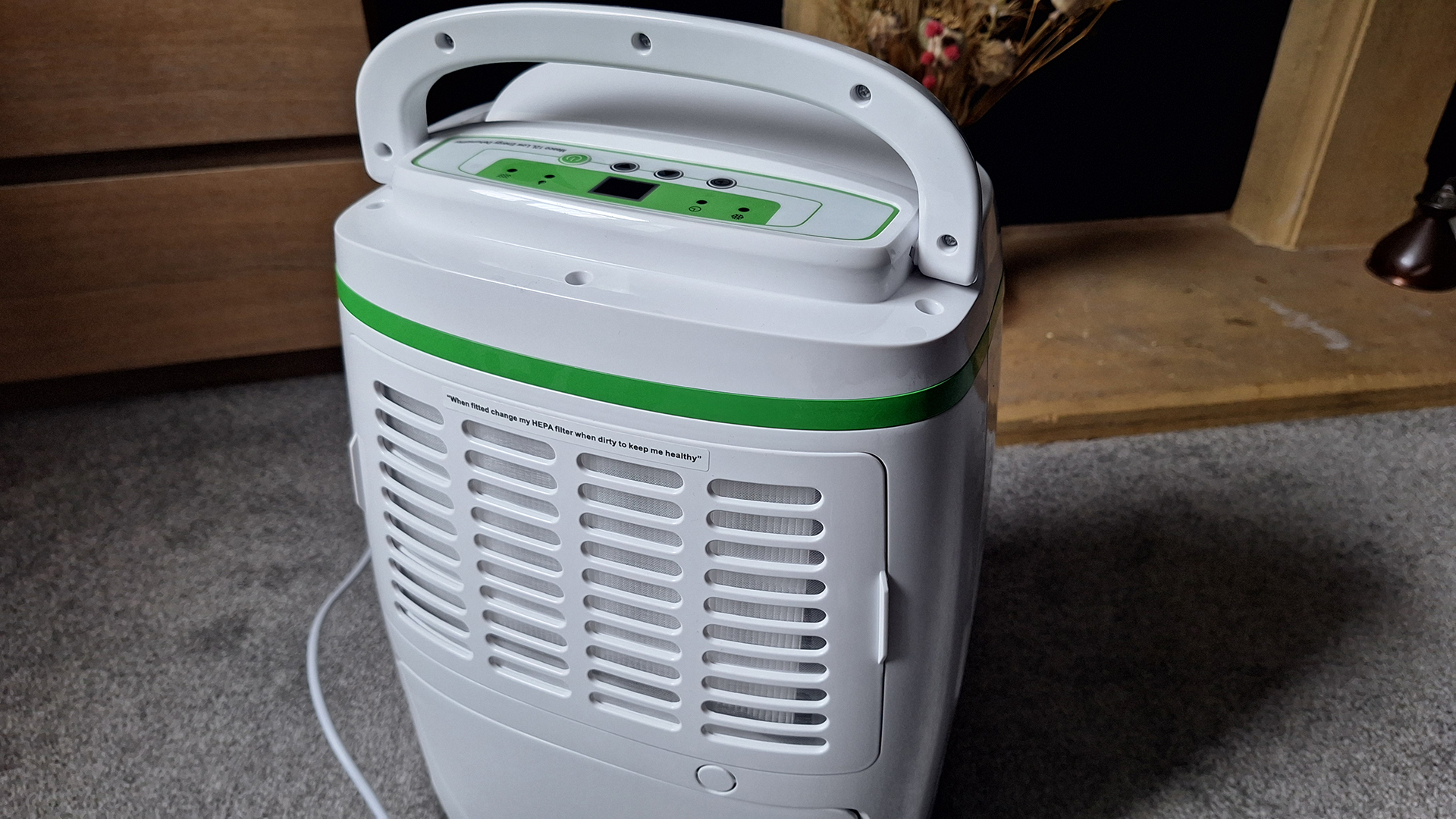
Today's most advanced air purifiers can monitor air quality in a space, switch on and off as needed to clear particles, and provide you with plenty of data to browse at your leisure. There's none of that here. It's worth noting that the purification itself should be just as good as it is on most other models; it's just that it isn't smart enough to be responding intelligently to pollution levels, and it won't tell you if the air is clear or not. As a result, it's a little tricky to test out.
- Performance score: 4.5 out of 5
Should you buy the Meaco Low Energy Dehumidifier?
Attribute | Notes | Rating |
|---|---|---|
Value | Top of the mid-range price bracket at full price, but discounts are fairly common. Decent value for quality, but alternatives offer more for the same price. | 3.5 / 5 |
Design | Basic but functional aesthetic, useful setting options, but fiddly controls. | 3.5 / 5 |
Performance | Primarily a dehumidifier, and all operations work reliably as advertised. Air purification is incidental, so don't expect the functionality of a dedicated purifier. | 4 / 5 |
Buy it if...
You're short on space
This two-in-one model can be used as a purifier in the summer when allergens are rife, and a dehumidifier in the winter when everything is damper and colder. Alternatively, it can do both things at once.
You want a dehumidifier that's cheap to run
This model has been optimised for energy efficiency, and costs around 4p (12L version) or 5p (20L version) per hour to run. It isn't the only dehumidifier on the market with such low running costs, but it's definitely on the cheaper end.
Don't buy it if...
The Arete Two is in stock for a similar price
Meaco's Arete Two is all-round a better machine than the Low Energy model tested here, including being cheaper to run. At list price, it costs the same, so it's hard to recommend the Low Energy model.
You want advanced air purification
The purification here is incidental; the main focus is on the dehumidification. If you want intelligent purification and data on air quality, you'll need a dedicated purifier.
You want a stylish dehumidifier
It's rare to find a particularly stylish dehumidifier, but this one is particularly functional looking. There are smarter and more streamlined machines on the market, if that's important to you.
Meaco Low Energy Dehumidifier: alternatives to consider
| Header Cell - Column 0 | Meaco 12L Low Energy Dehumidifier (tested) | Meaco Arete Two 10L Dehumidifier | Meaco Arete One 12L Dehumidifier |
|---|---|---|---|
Size (D x W x H): | 24.8 x 32.5 x 48.5cm | 23.7 x 31.9 x 49.2cm | 23.7 x 31.9 x 47.2cm |
Weight: | 10kg | 10.9kg | 10.9kg |
Max airflow: | 100m³/h | 140m³/h | 100m³/h |
Filter type: | HEPA | H13 HEPA | HEPA |
Noise level: | 41dB | 35, 38 and 44dB | 35 and 38dB |
Power consumption: | 157W | 136W | 151W |
Night mode: | No | Yes | Yes |
Cost to run (based on 24.50p/kWh): | 4p / hour | 3p / hour | 4p / hour |
Tank size: | 2.5L | 2.5L | 2.5L |
Controls: | Buttons, basic digital display | App, voice commands (Google/Alexa), LCD panel | Buttons, basic digital display |
Size options: | 12L or 20L | 10L, 12L or 25L | 10L, 12L, 20L, 25L |
List price: | £198.95 (view here) | £199.99 (view here) | £179.99 (view here) |
Meaco Arete Two dehumidifier
The main competition in the Meaco range seems to be the Arete Two. It has a more streamlined and stylish design, and boasts a range of extra features on top of what you get with the LE, including app control and a quieter night mode. It's also cheaper to run. Pricing is very similar, so it's difficult to recommend the LE over the Arete Two.
Meaco Arete One dehumidifier
The Arete One offers very similar features and specs to the LE, but in a more streamlined and stylish package.
How I tested the Meaco Low Energy Dehumidifier
I used the Meaco 12L Low Energy Dehumidifier regularly over the course of three weeks in January and February, in my one-bed basement flat. I tried the dedicated dehumidifier mode and combination mode to help with drying clothes and removing moisture from my bedroom (which is prone to condensation on the walls). I also ran tests to see how well it could clear odours from cooking and spraying dry shampoo in air purification-only mode. I tested the various functions, assessed ease of use and build quality, and compared performance to other dehumidifiers I've used.
Read more about how we test
- First reviewed February 2025

Ruth is TechRadar's Homes Editor specializing in air (vacuum cleaners, fans, air purifiers), and hair (hair dryers, straighteners and stylers). She has been in consumer journalism since 2020, reviewing and writing about everything from outdoor kit to mattresses and wellness gadgets, with stints on Tom's Guide and T3.
You must confirm your public display name before commenting
Please logout and then login again, you will then be prompted to enter your display name.
